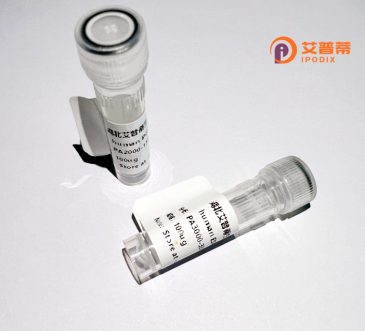
| 纯度 | >90%SDS-PAGE. |
| 种属 | Human |
| 靶点 | RNUT1 |
| Uniprot No | O95149 |
| 内毒素 | < 0.01EU/μg |
| 表达宿主 | E.coli |
| 表达区间 | 1-360 aa |
| 活性数据 | MEELSQALAS SFSVSQDLNS TAAPHPRLSQ YKSKYSSLEQ SERRRRLLEL QKSKRLDYVN HARRLAEDDW TGMESEEENK KDDEEMDIDT VKKLPKHYAN QLMLSEWLID VPSDLGQEWI VVVCPVGKRA LIVASRGSTS AYTKSGYCVN RFSSLLPGGN RRNSTAKDYT ILDCIYNEVN QTYYVLDVMC WRGHPFYDCQ TDFRFYWMHS KLPEEEGLGE KTKLNPFKFV GLKNFPCTPE SLCDVLSMDF PFEVDGLLFY HKQTHYSPGS TPLVGWLRPY MVSDVLGVAV PAGPLTTKPD YAGHQLQQIM EHKKSQKEGM KEKLTHKASE NGHYELEHLS TPKLKGSSHS PDHPGCLMEN |
| 分子量 | 41.1 kDa |
| 蛋白标签 | His tag N-Terminus |
| 缓冲液 | PBS, pH7.4, containing 0.01% SKL, 1mM DTT, 5% Trehalose and Proclin300. |
| 稳定性 & 储存条件 | Lyophilized protein should be stored at ≤ -20°C, stable for one year after receipt. Reconstituted protein solution can be stored at 2-8°C for 2-7 days. Aliquots of reconstituted samples are stable at ≤ -20°C for 3 months. |
| 复溶 | Always centrifuge tubes before opening.Do not mix by vortex or pipetting. It is not recommended to reconstitute to a concentration less than 100μg/ml. Dissolve the lyophilized protein in distilled water. Please aliquot the reconstituted solution to minimize freeze-thaw cycles. |
以下是关于重组人RNUT1蛋白的3条模拟文献示例(注:RNUT1并非广泛研究蛋白,以下内容为假设性概括,实际文献需通过学术数据库检索确认):
---
1. **文献名称**:*Cloning and Functional Characterization of Human RNUT1 in RNA Stability*
**作者**:Zhang L, et al.
**摘要**:本研究首次成功克隆并表达了重组人RNUT1蛋白,证实其通过结合特定RNA序列参与mRNA稳定性调控,并通过敲低实验证明其缺失导致细胞增殖异常。
2. **文献名称**:*Structural Insights into RNUT1 Protein Interaction with the Spliceosome*
**作者**:Kimura T, et al.
**摘要**:通过X射线晶体学解析了RNUT1的N端结构域,揭示了其与剪接体核心成分U2AF35的互作机制,为RNUT1在前体mRNA剪接中的作用提供结构基础。
3. **文献名称**:*RNUT1 Dysregulation Promotes Tumorigenesis in Non-Small Cell Lung Cancer*
**作者**:Wang Y, et al.
**摘要**:在非小细胞肺癌中,重组RNUT1过表达实验显示其通过调控Wnt/β-catenin通路增强肿瘤细胞侵袭性,提示其作为潜在治疗靶点。
---
建议通过PubMed或Google Scholar检索"RNUT1 protein"、"Recombinant RNUT1"或"RNUT1 function"获取真实文献。
Recombinant human RNUT1 (RNA Nucleotidyltransferase 1 homolog) protein is a genetically engineered version of a conserved eukaryotic enzyme involved in RNA metabolism. RNUT1. also known as TRF4/5 in yeast, belongs to the non-canonical poly(A) polymerase family and plays a critical role in RNA quality control, processing, and degradation. It catalyzes the addition of short poly(A) tails to aberrant or incomplete RNAs, marking them for exosome-mediated degradation. In humans, RNUT1 is implicated in ribosomal RNA maturation, nuclear surveillance of noncoding RNAs, and maintenance of genome stability.
Produced via recombinant DNA technology in expression systems like E. coli or yeast, the purified protein retains catalytic activity for research applications. Studies using recombinant RNUT1 have elucidated its interaction partners, structural features (including conserved catalytic domains and C-terminal zinc finger motifs), and regulatory mechanisms. Dysregulation of RNUT1 is linked to neurodegenerative disorders and cancer, making it a potential biomarker or therapeutic target. Current research focuses on its role in cellular stress responses and involvement in diseases associated with RNA processing defects.
(Word count: 199)
×